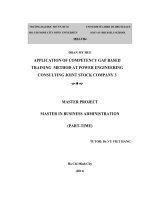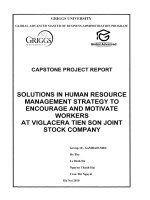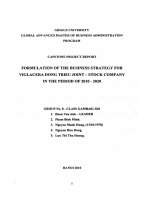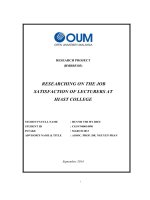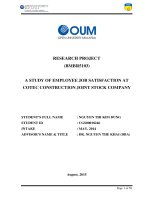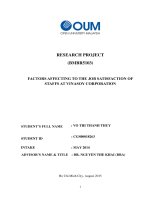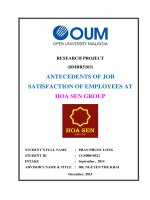Job satisfaction of operation management department at industrial equipment trade joint stock company
Bạn đang xem bản rút gọn của tài liệu. Xem và tải ngay bản đầy đủ của tài liệu tại đây (443.85 KB, 11 trang )
JOB SATISFACTION OF OPERATION MANAGEMENT
DEPARTMENT AT INDUSTRIAL EQUIPMENT TRADE
JOINT STOCK COMPANY
MBA Vu Tri Tuan
EMBA, National Economics University, Hanoi, Vietnam
Abstract
The paper analyzes the job satisfaction of employees at the Operation Management
Department of Industrial Equipment Trade Joint Stock Company (IETC) based on Job
Description Index model, as well as proposes solutions to improve job satisfaction.
Responses for surveys and questionnaires were collected from all 84 members of the
department. Results show that satisfaction levels of factor “Pay”, “The work itself”, and
“Promotions and promotion opportunities” are neutral; meanwhile “Coworker” and
“Supervision” have satisfied level. This leads to overall job satisfaction at the level of
neutral. Therefore, improving policies on Pay, supervisors‟ capabilities, and activities to
connect “Coworkers” is recommended to increase job satisfaction.
Keywords: Job satisfaction, Operation Management Department, satisfaction levels
of factor, solution.
1. Introduction
Job satisfaction has been a hot topic recently. Managers and specially HR managers
have paid a close attention. In Vietnam, after joining different local and international
organizations such as ASEAN, WTO, or WB, the HR market becomes more competitive
for companies. Supply for jobs is higher than demand. Quality employees place high
requirements for companies to work for. Some workers rank criteria for an organization:
Wage - Opportunity to promoted - Welfare. Some others list out: Working environment –
Welfare - Colleagues. The job of managers is to find out talented employees and make
them satisfy with the job. However, with the Vietnamese working culture, job satisfaction
just has been focused and analyzed for not so long. And most of solutions are not applied
professionally.
Besides, in industrial equipment, there have been few researches of job satisfaction
because changing jobs among industrial equipment companies is so common because this
field is not popular anymore. The author believes that the research would be the first on dig
to a specific level of studying the employees‘ job satisfaction in industrial equipment field
than any researches before.
Most of managers admit that it is a big lost when a staff leaves. The lost is
combination of cost, knowledge, and time. The head of Operation Management
875
Department (OMD) of Industrial Equipment Trade Joint Stock Company (IETC) once said
that he would never hired people from Foreign Trade University again, because they do not
stay for a long time. According to his experience, he had had 5 talented employees from
Foreign Trade University. They had all changed to different departments or different
companies after at most two years. It takes time for the manager to find other good people,
and to train them. It puts pressure on other team members. All makes up to a huge cost.
Thus, evaluating factors that affect employees‘ job satisfaction is a smart move. Managers
will know what to change to keep important staffs, and avoid the brain drain.
Within many Departments of IETC, Operation Management is the core Department.
Since 2014, there have been 15 members moved out of the Department. And the number
tends to rise. In order to get dig deeper to see if employees are actually satisfied with the
work they do, it is necessary to do the study of Operation Management Department
employee‘s job satisfaction at IETC. The job satisfaction of employees will give
employees all reasons to stay with OMD happily. It also helps the manager to have a stable
team for a better outcome.
The Job Descriptive Index model (JDI) is the model the author used. It developed
by Smith et al. (1969) at Cornell University in the United States. It has 72 questions to
measure 5 factors: supervision, coworkers, pay, promotional opportunities, and the work
itself. It has been valued in both research and practice. Participants were asked to think
about specific aspects of the job and to evaluate their satisfaction with specific aspects. It's
included with Spector's (1997) Job Satisfaction Survey (JSS) and Weiss et al.'s Minnesota
Satisfaction Questionnaire (MSQ). (1967) are the three tools in job satisfaction
measurement, in which JDI and MSQ are two tools widely used in practice and theory
(Green, 2000). According to Worrell (2004), in about 30 years since its inception, 1200
different studies have used JDI to measure job satisfaction. The JDI model was originally
designed with 72 different questions about the five elements of work: (1) the work itself,
(2) promotions and promotion opportunities, (3) supervision, (4) coworker and (5) pay.
- Pay: refers to the employee's perceptions of fairness (internal and external) in
payment. Obviously, the higher payment a worker gets, the higher satisfaction level the
worker has. Pay can be seen as one of the first factor when a person is looking for a job.
And it is also one of the first and most important factor that a person thinks of to evaluate
job satisfaction. Pay is not the most important reason an employee work for a company,
and it should not. But pay provides what employees need.
- Promotions and promotion opportunities: involves employee perceptions of
opportunities for training, personal development, and opportunities for promotion within
the organization. According to Kreitner and Kinicki (2001), development chances is
proportional to job satisfaction only if perceptions of employees are fair. Promotion
opportunities have shown in many Vietnamese studies having positive impact on job
satisfaction: Tran Kim Dung, (2005); or Ha Nam Khanh Giao (2011).
- Coworkers: Coworker relationship in the workplace. Friendly and helpful
coworkers are tremendous important factor that whether the job satisfaction is negative or
876
positive, according to Kreitner & Kinicki (2001). A place with full of nice and openminded colleagues would never be a dissatisfied place.
- The work itself: involves the challenges of the job, the opportunity to use personal
abilities, and the joy of doing the job. According to Loke (1995) and Luddy (2005), job
satisfaction depends on the nature of the job. The link of work to the worker is shown in
many angles of the nature of the job. What is the usage of skills? How the work flow is
understood? How important a certain job is? More essentially, the work itself has to fit
with employees‘ capacity.
- Supervision involves the relationship between the employee and the immediate
supervisor, the supervisor's support, the leadership style and the leadership's ability to
perform organizational functions in the organization. Job satisfaction can be affected by
the relationship with supervisor positively or negatively. The feeling when talking, eye
contacting, smiling can imply many things. Employees can see the respect from
supervisors through the mean of communication. A manager who comes to a staff‘s table
to assign tasks carefully and friendly is different than a boss who calls out loud a staff to
come and assign the job without any details. The impacts to JS are opposite. (Robins,
2002). According to Ramsey (1997) morale connects significantly with leadership. Mean
bosses would never stay long with employees. People need to be on the same side in order
to empathize to each other. By that, stress would be reduced and JS would be increased.
2. Method
The Research process is followed:
1. Determining Research Objectives
2. Classifying dimensions to measure job satisfaction
3. Data collection:
- Primary data: In – depth Interviews and questionnaire surveys
- Secondary data: OMD reports, and other relevant reports
4. Analyzing current employee job satisfaction
5. Proposing Solutions
For data collection, both primary and secondary data were used in conducting the
research. Secondary data were collected through the IETC‘s labor agreements, IETC‘s
structure, HR management policies, HR management rate, and other relevant reports.
Besides that, secondary data were also collected from books, articles, journals, handouts in
human resources development and the internet.
To collect primary data, questionnaires were given out through emails to 84
members of OMD, not including head of departments and head of divisions. Responses
were collected via emails. The questionnaires are designed based on the measuring
employee job satisfaction with questions of multiple choices, using 5 point likert scaling
system. 1 to 5 represents from totally dissatisfied to totally satisfied.
The author constructed a questionnaire on the Likert scale of 5 in the questionnaire.
The significance of each mean value to the Interval Scale was determined as follows:
877
Distance value = (Maximum - Minimum) / n = (5 - 1) / 5 = 0.8
Thus, range of mean for totally dissatisfied is 1.00 – 1.8; 1.81 – 2.60 is
Dissatisfied‘s range of mean; 2.61 – 3.40 is Neutral‘s; 3.41 – 4.20 is Satisfied‘s; and 4.21 –
5.00 is Totally satisfied‘s. (Source: Statistical book of socio-economic application - Chu
Nguyen Mong Ngoc and Hoang Trong, 2008)
In the questionnaire, 23 variables are observed to measure 5 dimensions of job
satisfaction as follows:
- The work itself (4 variables):
+ The work is suitable for staffs‘ professional knowledge and skills;
+ The work is as expected;
+ The amount of work is suitable;
+ Work is motivated.
- Promotions and promotion opportunities (5 variables):
+ Training programs for new employees are available;
+ Training programs for senior employees are available;
+ Opportunities to be promoted are various;
+ Promotion program is fair;
+ Programs to develop employees‘ personal capacity are available.
- Supervision (6 variables):
+ Supervisor treats employees fairly;
+ Supervisor listens and respects employees‘ opinions;
+ Supervisor is professional at work;
+ Supervisor motivates employees;
+ Relationship between supervisors and employees is good;
+ Supervisors assign works based on employees‘ skills and knowledge.
- Coworkers (4 variables):
+ Good relationship with coworkers;
+ Good cooperation with coworkers;
+ Coworkers are friendly and caring;
+ Coworkers are willing to share knowledge and experience.
- Pay (4 variables):
+ The pay can cover monthly expenses;
+ The pay is paid fully and timely;
+ The pay is commensurate with the volume and complexity of my work;
+ The pay is commensurate with the outcome.
(Source: Smith, Kendall, and Hulin (1969))
878
The author also had in – depth interviews with the Head of Department, 2 Heads of
Divisions and 3 employees. These interviews are to deeply understand on current job
satisfaction situation at OMD. It involves opening questions and direct questions to factors
affecting job satisfaction.
The data collected from the questionnaire were analyzed and categorized according
to the factors: gender, age, academic qualifications, and seniority. Mean, frequency,
maximum value, and minimum value are calculated and represented at tables and figures.
The items were grouped based on the responses given by the respondents. This method is
suitable to identify, compare, describe and reach a conclusion.
3. Results
―The work itself‖ is one of the most important aspects to attract human resources. It
is the first consideration when a person decides whether to choose the job. The work itself
is influenced by 4 observational variables, including: The work is suitable for staffs‘
professional knowledge and skills; The work is as expected; The amount of work is
suitable; Work is motivated.
The mean value of the variable ―The work is suitable for staffs‘ professional
knowledge and skills "has the highest mean value of 3.33, followed by the variable " The
work is motivated ". Its mean is 3.32 which is in the 2.61-3.40 group. It indicates that the
current job may be motivated, maybe not. It might depend on the actual job that people are
doing; It also depends on employee‘s expectation as well as understanding of the job.
―The work is as expected‖ has the mean of 3.19. It is not a high value. Similar to
the above questions, some employees of Operation Management Department are not so
happy with the job when their expectations did not meet the reality. According to a Head
of the Division, employees can be assigned to different jobs, in different location based on
the requirements. Thus, people can have work they did not want to at the beginning.
―The amount of work is suitable‖ has the lowest mean among 4 questions. It is in
the range of dissatisfied. 36 and 37 people had the answer of either dissatisfied or neutral. 7
people were totally dissatisfied. Only 4 people were satisfied. It indicates that the work in
OMD is not well-distributed. In reality, some employees have to have do OT 5 days/ week
without bonus. They simply have too much work that they cannot do within business
hours. Some divisions have to work on every Saturday. Oppositely, some people never
come home late.
The second dimension is "pay". We are looking at 4 important questions: Whether
payment is timely and fully? Whether payment is commensurate with volume and
complexity? Whether outcome and payment is commensurate? Whether payment is
enough? As condition in labor contract, and the culture in IETC as well as the Operation
Management Department, people would neither share their salaries nor ask other‘s pays.
Thus, pay is a sensitive issue.
The variable "Pay is paid fully and timely" with a mean of 3.6> 3.41. It shows that
all staffs of the OMD are satisfied with the payment of wages. Staffs get paid in full on
879
10th of each month. Pay is never late with detailed description. More than half of OMD
employees feel satisfied with this factor. It accounts for 60.71%. The rest stays neutral
which is 39.29%. Because the OMD belongs to IETC which is a government enterprise,
the pay is never late or not full. This is an advantage.
However, for the remaining variables, the results are completely contradictory.
With two variables, "The pay is commensurate with the volume and complexity of my
work," and " The pay is commensurate with the outcome," the results were not high,
averaging 2.76 and 2.9, respectively. It shows that the regimes and policies on
remuneration and evaluating the performance of the companies applying are not very
effective. It leads to the dissatisfaction of the employees. Particularly with the variable "
The pay is commensurate with the volume and complexity of my work," ", the mean was
2.76 <3.41.
Overall, the overall mean value of the "Pay" aspect was 3.04 < 3.41. It shows that
employees are not really satisfied with the current pay. Many employees argue that wages
do not really match the results. At the OMD, the difference between managers‘ and staffs‘
salaries is huge. While the number of employees accounts for a large proportion of the
OMD, the annual increase in staff salaries is negligible.
In this study, the "Co-worker" aspect was established from 4 observable variables.
In the relationship with colleagues, the author mentions the following variables:
relationships between co-workers, cooperation between co-workers, sharing between coworkers, and feeling toward each others.
The mean of the term ―Coworker‖ is 3.5. The mean is in the range of satisfied. It
indicates that people in OMD have a strong and tie connection with each other.
The variable "Coworkers are willing to share knowledge and experience" reached a
relatively high mean of 3.47. In general, the relationship between peers is very good, with
the highest mean of 3.6. The complexity of the work requires the coordination of staff
between departments. Thus, it is necessary to share experience and information that create
a relative harmony in the work environment at work. With 50 employees which is 60% of
respondents choose to say satisfied and more than satisfied, we can conclude that general
working environment at OMD is ideal
The remaining " Coworkers are friendly and caring‖ has a mean of 3.44. It
indicates that the staffs are quite satisfied when working in the corporate team. This is a
relatively positive result compared with other factors. With the characteristics of office
works and the culture of IETC, people in the OMD see each other as family members.
Thus, new staffs can immediately feel the warm welcome from old staffs. There are no
distances between coworkers.
Variables with a mean value greater than 3.5 indicate that employees are satisfied
with the attitudes of colleagues, as well as the coordination and support at work.
In this study, the author examines 6 variables of the "Supervision" aspect: fair
treatment, listening and respecting opinions, competence, motivation, relationships with
880
employees, and assigning for right people. All 6 variables have means in the satisfied range
- 3.41 to 4.20. Much better than the factor ―Coworker‖, ―Supervision‖ factor determine
that supervisors of the department of the OMD is qualified. In fact, all questions asked
about bosses at work all have means in the satisfied range. This never happens with others
factors: The work itself, Pay, and Coworker. Even though the mean of ―Supervision‖ is
lightly lower than the mean of ―Coworker‖, in my opinion, ―Supervision‖ is the one which
has the highest score.
"Supervision" is one of the aspects that greatly influence job satisfaction in the
workplace. When the work itself does not change, good leaders will know how to increase
job satisfaction. They will know how to allocate the right job to the right people, to treat
them fairly, and to create interpersonal relationships. The staff will feel more interesting
about their current job. More importantly, employees will feel motivated to accomplish the
assigned work. This also creates momentum for them to try harder for higher position.
The relationship between employers and employees is a two-way relationship.
Managers have the right to exchange, transfer, remit and evaluate employees. Employees have
the right to display their status, thoughts and behaviors. Employees also have the right to show
their opinions through the way supervisors manage works. From there, staffs can show respect
or concern about managers. Supervisors need to have a team of qualified staffs who know
what to do in specific jobs. On the other hand, employees need leaders who can have visions in
every step. They have to feel protected. This could be a win-win or lose-lose relationship.
Most of employees at the Operation Management Department in particular or IETC
in general have strong connections with many people. Many of them get the job through
connections. However, it does not mean that the OMD‘s supervisors treat people based on
their connections. People are treated based on commitments, results of work, attitudes, and
characteristics. The fairness in treatment can be seen through statistics. Only one person
(1.19%) felt completely not dissatisfied. Number of people satisfied is 29. And 8 people
are very satisfied. The total of 37 people accounted for about 35%
The variable "Supervisor motivates employees" has 3.41 as the mean. Even though,
this number is at the satisfied range, this equals to the minimum of the range. This is the sign
showing that supervisors need to do more on supporting employees. With this fragile statistic,
it is extreme easy for staffs to feel that their bosses do not encourage them at work. From there,
they would not feel the joy while working. A difficult task would get easier with motivation
from leader. Without it, an easy task would be finished with difficulties and excuses.
With "Supervisors assign works based on employees‘ skills and knowledge" the
mean is 3.56. This shows the satisfaction in capacity and administrative management of the
leader at the OMD. It is significant for a good manager to use the right person for the right
task. If an employee can fit in the right job, it will be the best situation. The job will be
done quickly and the employee can apply his skill and knowledge in the right place.
Especially in team work, if the managers do not understand all team members‘ abilities, it
will be the worst for the whole case. It can bring terrible results not only for the particular
job, but also for relationships between colleagues.
881
It is no surprised seeing that "Supervisor is professional at work" has the highest
mean value of 3.59. The reason for this high score is the number of totally satisfied
employees. 16 people totally agree with this question. This is the highest score in the
whole survey also.
The variable ―Relationship between supervisors and employees is good‖ has mean
of 3.52. This is relevant to the mean of ―Coworker‖. Both show that OMD has a strong
connected bond between people. The environment between employees and employees; and
employees and employers is very friendly and comfortable.
In conclusion, the management team has positive effect on staffs. They know how
to listen to employees, and encourage them to work harder. This is a good result, showing
that the manager has understood to provide opportunities for qualified people. This is a
strong point to keep people stay at the OMD.
The aspect of "Promotions and promotion opportunities" was surveyed on 5 variables:
Training programs for new employees; Training programs for senior employees; Promotion
opportunities; Fairness of promotion; Programs to develop employees‘ personal capacity.
3 variables about training programs have means in Neutral range. This makes the
mean of the aspect is in range of neutral also. Even though, the other 2 variables have the
satisfaction from employees, it cannot change the fact that, promotions and promotion
opportunity of the Operation Management Department is just working ok.
―Training programs for new employees are available‖ is the variable has the most
totally dissatisfied opinions by employees. 4 of them accounts for 4.76%. Some new
employees might be unlucky by not able to attend training programs. Annually, there are 2
training programs on July and December. Thus, new employees who attend the
Department a little later than December have to wait until the next July. At that time, these
employees have already known knowledge which they would have been taught in the
program. This might be the reason for the 4 highly dissatisfied opinions. Oppositely, there
are 5 totally satisfied opinions accounted for 5.95%. These 5 people might be employees
who have entered new training program right after they got accepted to the OMD. In
general, period of time for 2 training classes for fresh employees are not reasonable. This
leads to the neutral opinion of the first variable.
For ―Training programs for senior employees are available‖, the mean is neutral
also. 34 people which are 40.48% have neutral opinion. Related to promotions, it is
necessary for seniors to have trained before promoted. Thus, only people who are in the list
of promotion are able to participate in these classes. It is easy to know why this class can
be available for some staffs, but it cannot for others.
―Opportunities to be promoted are various‖ are satisfied by most of employees in
the OMD with the mean of 3.49. This is the highest value in this aspect. No one totally
dissatisfied with this opinion. Only 5.95% (5 people) dissatisfied. This value approves that
promotion opportunities in the OMD is transparent for everyone. Staffs know about it and
they know how steps to turn that opportunities to reality. Normal staffs in the Department
882
can be promoted to team leaders, or Heads of Divisions or Departments. They can also be
promoted to managers of unit companies.
Supported to the fact that promotion opportunities in the OMD are transparent for
everyone, the variable ―Promotion program is fair‖ gains satisfaction from staffs. The mean
is 3.41. However, there are more neutral opinions. It is easy to understand. The fairness is
difficult to identify. In many situations, it can be fair with one person, and it is unfair with
another. 41 people which is almost half of the OMD‘s employees have the same thought.
4. Discussion and Conclusion
Job satisfaction does not merely focus on satisfying one factor. It is the combination
of many. 5 most fundamental aspects that the author has studied about are the work itself,
promotions and promotion opportunities, supervision, coworkers, and pay. In order to
reach a certain level of job satisfaction, it is necessary to harmonize those factors. Practical
research shows that skillful employees are highly productive. But it is difficult for the
company or the department to keep them working. Therefore, ensuring the increase of staff
satisfaction in work, maintaining good human resources is a big task, which is considered
the strategic goal of all enterprises and organizations.
Key Performance Indicators (KPI) for every employee need to be reviews monthly
or quarterly aggressively. It will tell immediately whether the staff and the job are suitable.
If the employee performs well, he or she should be encouraged and enabled to perform
better. If the assessment shows inconsistencies between the employee and the position, the
manager can carry out the rotation of employees in the OMD. He/ She should be assigned
to different team or divisions for better outcome.
In terms of working time, there should be support for employees who do OT. The
current overtime calculation is on weekends and according to work plans only. To motivate the
employees, the OMD need to also count OT on weekdays also. And people who do not have
the work plans but work on weekends also should be paid. These pays might be lower.
At present, the total monthly income of employees is calculated as the total of fixed
salary, allowances (if any), overtime pay (if any), minus personal income tax (if any),
social insurance, health insurance, unemployment insurance, union‘s fee, and other
advances and deductions (if any). But to improve employee satisfaction with payroll, the
HR department should implement plans that cover additional pay based on KPIs. KPIs
should be reviewed quarterly, monthly and annually. In order to record the level of
accomplishment of an employee's work, assessment of competency/level, level of
dedication, impact of the job position that the employee is undertaking, the Human
Resources Department needs to immediately adjust staff pay on the principle of competing
with other departments or companies of the same size. Salary adjustments are made in two
rounds of the year, in May and October. The employee's salary adjustment must meet the
following conditions:
- Employees have a minimum working time of at least 12 months (excluding unpaid
leave, maternity leave, etc.) since the last salary adjustment at the company.
883
- Employees must achieve KPIs. Employees should not violate discipline or who
are not subject to employee disciplinary action within the six months preceding the salary
adjustment period.
- Adjustment rates are based on the difference between the employee's current
salary and the salary reference as well as the level of employee completion.
In addition to a fixed monthly wage, employees may receive additional pay such as
seniority allowance of 1% of total basic salary; additional staff allowance after each year of
seniority; 1% per month but not exceed 8% per month. Seniority allowances are paid to
employees who worked for more than 2 years at the Department.
Seat arrangement, birthday celebration, having lunch together are few basic
activities that brings colleagues together. Organizing sports events, or attending volunteer
activities, and social works are other options. These activities on weekend or holidays are
joyful for staffs and their families. These actually are so profitable for the image of the
Department and BVL. It helps to increase the value of the company.
Supervisors should listen to and acknowledge employees' opinions in order to give
compliments when employees do a good job, and to have reminders when employees have not
done their job well. Supervisors should show reasons why job is not done the way it is
supposed to be done, and solutions for the particular case. Above all, Heads of Department or
Divisions need to let people know that the OMD cannot be success without employees‘ values.
Listening to employees is essential to building the OMD‘s culture of behavior.
Leaders listen to employees, encourage them to express their views and thoughts on the
job, promote creativity in their work, and assist employees to complete their work. The
work which is well-structured must be treated fairly with other employees‘. For example,
the OMD may organize programs called "Employee Gratitude Month" This is the event
where employees and supervisors can be closer together. They can also talk, and share
opinions, workload as well as recommendations for each Divisions.
Building a "One day supervisor" program for departmental staff so that as
employees can understand the responsibilities. Thanks to that, employees will have
sympathy to their managers and try to cooperate more. It also helps individual leaders to
identify potential employees for appropriate remuneration policies and policies.
Develop and implement staff competency assessments at each division in the OMD.
When the Department or the Company needs management level, priority should be given
to internal employees based on the results of the evaluation. Promotion opportunities need
to be transparent. This is a motivational tool that encourages employees to strive for the
best in their work.
The Department should pay more attention to training professional knowledge and
skills. All of employees at the OMD have training course of their positions. However,
these courses are just an overview. They should be longer and more specific. Moreover,
there are no courses to provide knowledge of different divisions. It is a prevention for
employees when opportunities come to change positions in different divisions. Therefore,
884
it is necessary to have a clear training policy which is reasonable and appropriate to the
reality. At the same time, it requires a professional training team with both professional
qualifications and practical experience to improve the quality of training.
Develop a career development process for each position so that employees know
what qualifications and skills they need to develop in order to be qualify for a higher
position. Requirements for each position in the Department, even the Head of Department
must have a detailed description so that each employee can grasp and constantly improve
themselves. Information of pay, bonus or welfare for each position should be provided.
5. References
1. Annual report of Industrial Equipment Trade Joint Stock Company 2004 -2016
2. Hà Nam Khánh Giao và Võ Thị Mai Phương (2011), Đo lường sự thỏa mãn
công việc của nhân viên sản xuất tại Công ty TNHH TM – DV Tân Hiệp Phát, Báo Phát
triển kinh tế • Số 248 phát hành tháng 06/2011 (nguồn: www.tcptkt.ueh.edu.vn).
3. Job
Descriptive
Index.
Bowling
Green
State
University.
/>4. Jony Ive Reveals The Secret Of Apple's Design Strategy, source:
/>5. K. R. Sowmya1 * and N. Panchanatham: Factors influencing job satisfaction of banking
sector employees in Chennai, India.
/>6. Nguyễn Khánh Duy (2009), Bài giảng: Thực hành mô hình cấu trúc tuyến tính
SEM với AMOS, Đại học Kinh tế thành phố Hồ Chí Minh.
7. Robert Hoppock: Job Satisfaction-Researches of 1935-1937
8. Smith, P.C., Kendall, L.M., & Hulin, C.L. (1969), The searurement of
satisfaction in work and ritirement, Chicago, Rand McNally.
9. Spector (1997), Job satisfaction application assessment, Causes, and,
consequesces, Thourand Oaks, Califonia.
10. The Top 10 Factors For On-The-Job Employee Happiness, source:
/>11. Trần Kim Dung (2005), Đo lường mức Ďộ thỏa mãn Ďối với công việc trong
Ďiều kiện của Việt Nam, Tạp chí phát triển khoa học, 8, 1 - 9
12. T. Ramayah, Job Satisfaction: Empirical Evidence for Alternatives to JD, T.
Ramayah, School of Management University Sains Malaysia, 11800 Penang, Malaysia.
13. Walmart
Sustainability,
responsibility/sustainability/
source:
/>
885


